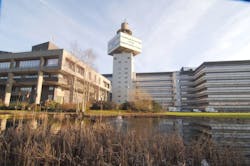BT is in the latter stages of testing the applicability of hollowcore fiber to applications such as 5G mobile network support. The UK incumbent service provider has partnered with hollowcore fiber supplier Lumenisity and Open Radio Access Network (O-RAN) mobile vendor Mavenir on the evaluations, conducted at the BT Labs in Adastral Park, Ipswich. The hollowcore fiber is performing well so far, BT sources indicate.
The tests began within the last two months of 2020, according to Andrew Lord, BT’s head of optical network research. “This fiber has moved a lot in the last few years,” he said, particularly in terms of lowering loss. The 10 km of cabled hollowcore fiber under test has exhibited loss of approximately 1 dB/km, “not too far off from single-mode fiber,” according to Lord. (The University of Southampton, from which Lumenisity spun out, has reported 0.28 dB/km in uncabled fiber.) The Lumenisity hollowcore fiber is based on a process called nested anti-resonant nodeless fiber (NANF; see "Startup Lumenisity unveils hollowcore fiber cables for DWDM applications, new funding"), which Lord opined appears to provide a better pathway to single-mode-like loss figures than other approaches such as photonic bandgap.
As the name implies, the hollowcore fiber under test supplants the silica core common in conventional fibers with a hollow, air-filled core. The lack of a silica core removes some of the transmission impediments the silica presents, which can enable such benefits as lower latency and zero nonlinear effects.
The lower latency – an approximately 1.5-µsec/km reduction versus standard single-mode fiber – could prove beneficial in 5G applications, the evaluations have demonstrated. Working with Mavenir, BT has shown that the lower latency the hollowcore fiber provides can extend the length of connections between hub sites and antennas while staying within the necessary latency window. A single exchange could therefore support a greater number of antennas, the tests indicate.
In addition to mobile networks, hollowcore fiber cable also could prove beneficial in quantum key distribution (QKD) networks (although Lord indicated he’d like to see lower loss for such applications). The technology’s latency attributes have already attracted the attention of high-frequency traders (see, for example, “High-frequency traders using hollow core fiber: Wall Street Journal”). Lord also noted that hollowcore fiber’s resistance to nonlinear effects could prove beneficial in coherent transmission applications, where its properties could reduce the need for complex digital signal processing.
How does it handle?
In addition to testing its performance, BT also has spent some time examining how the hollowcore fiber cable might handle in the field. Neil Parkin, optical networks research manager at BT, said that their evaluations indicated that conventional tools, set properly, should be adequate for splicing and related tasks. He did note that OTDR testing strategies would have to change, however. The lack of a silica core reduces back reflections, which means either a conventional fiber might have to be included in or alongside the hollowcore fiber cable or the reflectance sensitivity of the OTDR would have to be reset (for more on this point, see "Universities tout measurement of low back-reflection of hollow-core fibers").
Lord’s group does not make purchasing decisions, so he couldn’t say if BT plans to use hollowcore fiber cable. But he indicated that the evaluations so far had produced encouraging results.
For related articles, visit the Network Design Topic Center.
For more information on fiber cable and suppliers, visit the Lightwave Buyer’s Guide.
To stay abreast of fiber network deployments, subscribe to Lightwave’s Service Providers and Datacom/Data Center newsletters.

Stephen Hardy | Editorial Director and Associate Publisher, Lightwave
Stephen Hardy is editorial director and associate publisher of Lightwave and Broadband Technology Report, part of the Lighting & Technology Group at Endeavor Business Media. Stephen is responsible for establishing and executing editorial strategy across the both brands’ websites, email newsletters, events, and other information products. He has covered the fiber-optics space for more than 20 years, and communications and technology for more than 35 years. During his tenure, Lightwave has received awards from Folio: and the American Society of Business Press Editors (ASBPE) for editorial excellence. Prior to joining Lightwave in 1997, Stephen worked for Telecommunications magazine and the Journal of Electronic Defense.
Stephen has moderated panels at numerous events, including the Optica Executive Forum, ECOC, and SCTE Cable-Tec Expo. He also is program director for the Lightwave Innovation Reviews and the Diamond Technology Reviews.
He has written numerous articles in all aspects of optical communications and fiber-optic networks, including fiber to the home (FTTH), PON, optical components, DWDM, fiber cables, packet optical transport, optical transceivers, lasers, fiber optic testing, and more.
You can connect with Stephen on LinkedIn as well as Twitter.
